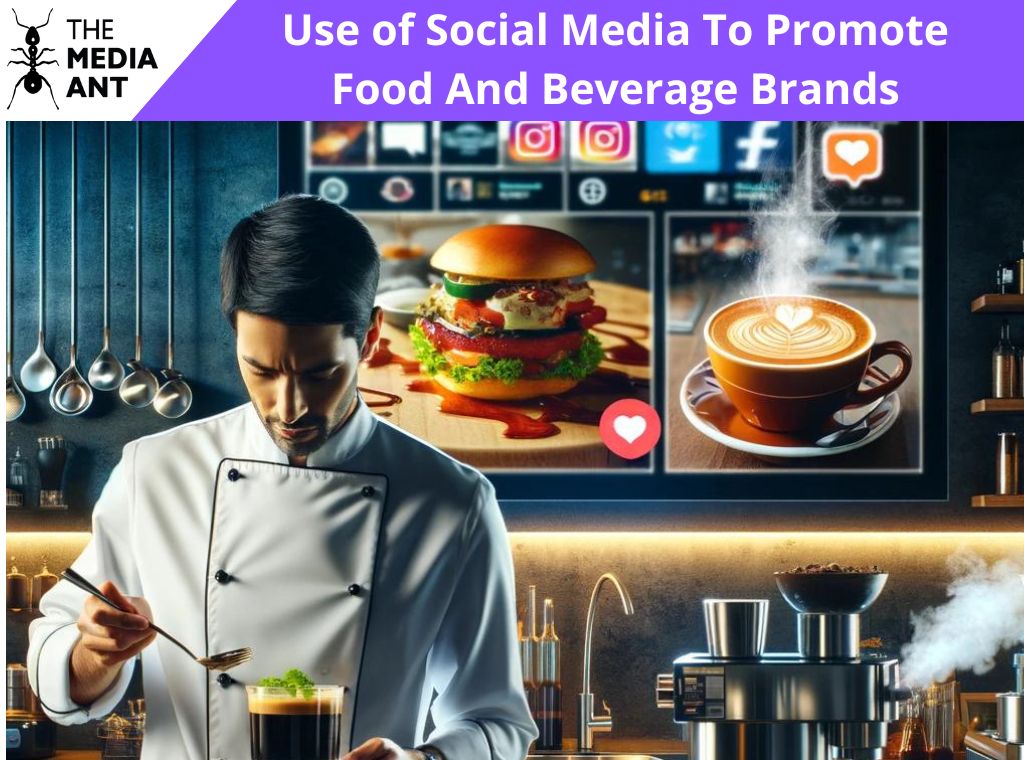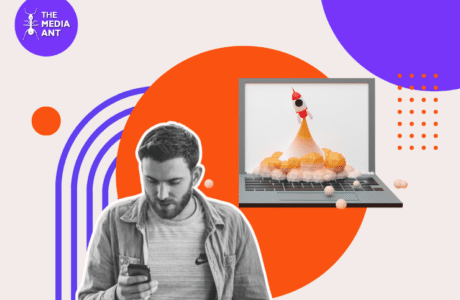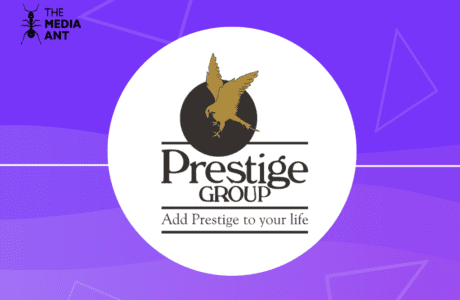In the bustling landscape of India’s food and beverage brands, social media has emerged as a pivotal battleground for brands striving to captivate the palates and preferences of one of the world’s most diverse and dynamic consumer markets. As digital connectivity soars, with millions of Indians accessing social media platforms daily, these virtual spaces have transcended their role as mere communication channels, morphing into influential forums where culinary trends are set, tastes are shaped, and brand loyalties are forged.
We’ll see how brands, big and small, utilize these platforms not just for promotion, but to create a community of food enthusiasts, turning every meal into a shared experience. In a country where food is not just sustenance but a part of its soul, social media has become the new dining table around which conversations, connections, and communities are built.
The Power of Social Media in Branding
1. Enhanced Brand Visibility and Sales Impact
- India’s vast and diverse social media user base, which includes over 448 million users as of 2021, offers unparalleled visibility for brands. This wide reach allows food and beverage companies to target various demographics across the country.
- Social media doesn’t just increase brand visibility; it also directly influences purchasing decisions. For instance, campaigns on platforms like Instagram and Facebook have been known to lead to immediate sales increases for brands like Amul and Haldiram’s.
2. Influence on Consumer Behavior
- Social media shapes how consumers perceive a brand. Creative and engaging content can position a brand as trendy, health-conscious, or connected to cultural roots, which is vital in a diverse market like India.
- Through interactive posts, polls, and direct messaging, brands like Café Coffee Day and Dabur have actively engaged with their audience, fostering a sense of community and loyalty.
3. Cost-Effective Marketing
- Compared to traditional advertising channels like television and print media, social media marketing is more cost-effective, offering a higher return on investment. This is particularly advantageous for smaller or regional brands in India.
4. Real-Time Feedback and Adaptability
- Brands receive instant feedback from their audience through comments, shares, and likes. This real-time interaction allows companies to gauge public reaction and adapt their strategies accordingly.
- Social media also provides a platform for swift public relations responses in case of any crisis, essential for maintaining brand reputation.
Popular Social Media Platforms for Food and Beverage Marketing
- Instagram’s visually driven platform is ideal for showcasing food and beverage products. High-quality images and videos of dishes or drinks can be very appealing to users.
- Features like Stories, Reels, and IGTV allow brands to create diverse content – from short clips to longer cooking demonstrations.
- Brands like Swiggy and Zomato use Instagram to highlight their array of culinary offerings, often featuring visually appealing dishes from various restaurants, engaging users through appetite-inducing visuals and interactive stories.
- With its vast user base, Facebook is great for reaching a diverse demographic in India.
- Facebook’s advanced targeting options allow food and beverage brands to reach specific audiences based on interests, behaviors, and location.
- Amul, with its iconic Amul Girl cartoons, frequently engages with current events and trends, creating relatable content that garners wide attention and shares on Facebook.
- Twitter is ideal for real-time conversations and customer service. Food and beverage brands can use it for quick responses, feedback, and trending campaigns.
- Hashtags can help increase the reach of campaigns. For instance, during festivals or cricket matches, Indian brands often create themed hashtags for promotions.
- Kingfisher often uses Twitter to engage with consumers during major cricket events, aligning their brand with the excitement of the sport.
TikTok and Indian Alternatives
- With TikTok banned in India, alternatives like Moj and Chingari have filled the void. These platforms are perfect for creating fun, engaging, and short video content.
- Participating in trends or creating brand-specific challenges can help in going viral and reaching a younger audience.
- Many local cafés and small food businesses use these platforms to showcase their special dishes, quirky recipes, or fun behind-the-scenes glimpses.
- Though not traditionally associated with food and beverage marketing, LinkedIn can be effective for B2B marketing, industry news, and establishing thought leadership.
- B2B food companies like Godrej Tyson Foods use LinkedIn to share industry insights, company news, and professional content, targeting other businesses and professionals in the industry.
YouTube
- Ideal for longer-form content such as cooking shows, recipe tutorials, and brand documentaries.
- YouTube being a Google product, benefits from Google’s search algorithms, helping in broader content visibility.
- Indian chefs and restaurants often use YouTube to share cooking tutorials and recipes, such as Sanjeev Kapoor’s channel, which showcases a variety of Indian and international dishes.
Future Trends in Social Media Marketing for Food and Beverage Brands
These trends indicate a dynamic and evolving landscape for social media marketing in the food and beverage industry in India. Brands that stay ahead of these trends, adapting to new technologies and consumer preferences, are likely to see greater success in engaging with their audiences on social media. Here’s a deeper look into this topic:
Increased Use of AI and Machine Learning
- Artificial Intelligence (AI) and Machine Learning (ML) are becoming pivotal in personalizing the customer experience. Brands can use these technologies to analyze consumer behavior and preferences, enabling them to deliver content that resonates with individual users.
- For instance, a beverage brand might use AI to analyze social media interactions and predict which flavors might be a hit in certain regions of India, thereby tailoring their marketing campaigns accordingly.
Rising Importance of Video Content
- Video advertising content, especially short-form videos, is rapidly gaining traction. With the popularity of platforms like Instagram Reels and YouTube Shorts in India, food and beverage brands are increasingly using engaging and succinct video content to captivate audiences.
- Brands might create short cooking shows, behind-the-scenes glimpses of food preparation, or showcase customer testimonials in a visually appealing manner.
Interactive and Augmented Reality (AR) Experiences
- AR offers immersive experiences that can make social media interactions more engaging. Indian brands could use AR to let customers virtually try their products or create interactive games that incorporate their products.
- For example, a tea brand might create an AR experience where users can explore different tea gardens from which the brand sources its leaves.
Voice Search Optimization
- As voice-assisted devices gain popularity in India, optimizing social media content for voice search will become crucial. Brands need to ensure that their social media content is easily discoverable through voice queries.
- This might involve using more natural, conversational language in their posts or hashtags to align with how people naturally speak.
Focus on Sustainability and Health Consciousness
- With growing awareness around health and sustainability, Indian consumers are increasingly gravitating towards brands that reflect these values. Social media marketing will likely see more content focused on health benefits, organic ingredients, and sustainable practices.
- Brands could highlight their farm-to-table processes, use of organic ingredients, or eco-friendly packaging in their social media narratives.
Leveraging User-Generated Content and Community Building
- Encouraging customers to create content can build a community around a brand. This trend is particularly relevant in the Indian context where word-of-mouth has a strong influence.
- Brands might encourage customers to share their meal experiences or recipe creations using the brand’s products, further amplifying reach and authenticity.
E-commerce Integration
- Social media platforms are increasingly integrating e-commerce features. Brands can leverage this trend by making it easier for customers to purchase directly from social media platforms.
- For instance, a snack brand could enable direct purchases through Instagram Shopping, simplifying the path from discovery to purchase.
Localized and Vernacular Content
- India’s linguistic diversity means that content in local languages can significantly boost engagement. Brands are likely to create more content in regional languages to connect better with a diverse audience.
- A beverage brand could create social media campaigns in multiple Indian languages to reach a wider audience base.
Data-Driven Strategies
- The use of analytics to inform strategy will become even more refined. By analyzing social media data, brands can gain insights into what content performs best, the best times to post, and which platforms are most effective for their target demographic.
- This could involve detailed analysis of engagement metrics to fine-tune marketing campaigns for maximum impact.
Case Studies of Successful Social Media Campaigns
1. Old Monk Rum – Reviving a Cult Brand
- Old Monk, a beloved Indian rum brand with a cult following, faced the challenge of maintaining its relevance in a market rapidly embracing new and international alcohol brands.
- Despite having a minimal advertising policy traditionally, Old Monk turned to social media to rejuvenate its brand appeal, particularly targeting the younger demographic.
- The campaign involved sharing nostalgic stories, user-generated content, and engaging with audiences through memories and experiences related to Old Monk.
- This approach not only strengthened the loyalty of existing customers but also attracted new, younger consumers. The brand leveraged its legacy while making it relatable to the modern social media-savvy audience.
2. Chai Point – Tapping Into the Urban Lifestyle
- Chai Point, a popular Indian tea retail chain, aimed to position itself as not just a beverage brand but a part of the urban Indian lifestyle.
- The focus was on showcasing their wide range of teas and the convenience of their delivery service, which resonates with the fast-paced life of urban India.
- They utilized platforms like Instagram and Facebook to showcase their products, customer testimonials, and behind-the-scenes content. They also highlighted their technology-driven delivery services.
- The campaign successfully positioned Chai Point as a modern, accessible brand, leading to increased brand recognition and sales. Their emphasis on convenience and variety appealed to the target urban audience.
3. Amul – Topical and Trending
- Amul, one of India’s leading dairy brands, is known for its unique and timely topical advertisements.
- Their strategy has been to stay relevant by creating content that is timely, often commenting on current events, festivals, and trends.
- Amul’s social media platforms are regularly updated with topical cartoons and posts. These are often humorous takes on current events, making them highly shareable.
- This approach keeps the brand constantly in the public eye. Amul has successfully managed to stay culturally relevant and maintain a connection with audiences of all ages.
4. Paper Boat – Nostalgia Marketing
- Paper Boat is a beverage brand known for its traditional Indian drinks. They aimed to evoke nostalgia and childhood memories associated with these flavors.
- The strategy was to connect emotionally with the audience by invoking memories of the past, related to the traditional Indian drinks they offer.
- Through storytelling on social media, using visually appealing images and narratives, they shared stories that many Indians could relate to, from monsoon memories to festival celebrations.
- The brand successfully created a strong emotional connection with its audience, leading to a loyal customer base and high engagement rates on social media.
5. Kingfisher – The King of Good Times
- Kingfisher, a leading beer brand in India, has always positioned itself around the theme of fun and good times.
- Their social media strategy was to associate the brand with music, sports, and lifestyle events that resonate with their target demographic.
- They sponsored events like the Indian Premier League (IPL) and music festivals, creating engaging content around these events, including live posts, behind-the-scenes footage, and contests.
- This approach reinforced Kingfisher’s image as a youthful and vibrant brand, deeply embedded in aspects of entertainment and leisure that their target audience enjoys.






This is an informative blog post on social media marketing for food and beverage brands. The post offers valuable insights and emphasizes the importance of having a strong digital presence. The content is well-structured and provides practical tips, making it a must-read for marketers who want to enhance their strategies in the dynamic food and beverage industry.